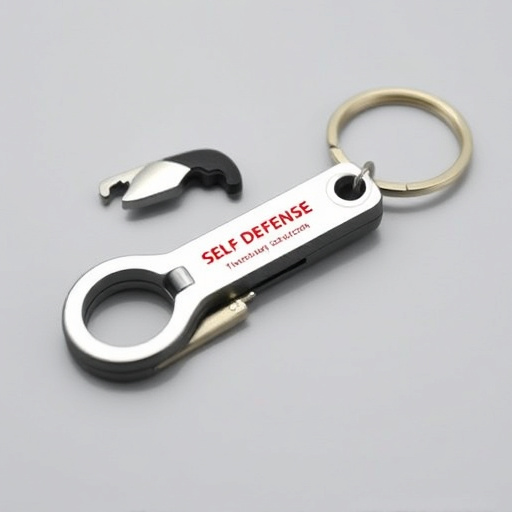Creating an ideal, functional, and aesthetically pleasing metal defense keychain requires mastering the Proper Keychain Striking Form Technique. This involves precise crafting of the gripping surface for secure yet comfortable handhold, tool preparation, material selection (e.g., stainless steel for corrosion resistance or titanium for tactical use), designing and cutting the metal, adding details, smoothing edges, and integrating robust locking mechanisms for security. The result is a reliable self-defense tool that offers both utility and comfort.
“Unleash the power of a well-designed metal defense keychain with our comprehensive guide. From the initial grip design to enhancing its defensive capabilities, we’ll navigate you through every step. Learn the art of choosing durable metal alloys and discover how the right ‘striking form’ technique can transform your keychain into a reliable self-defense tool.
Get ready to master the secrets behind creating an effective, secure, and stylish defense accessory with practical tips on keychain design.”
- Understanding Keychain Grip Design: The Basics
- Choosing the Right Metal Alloys for Durability and Strength
- Mastering the Striking Form Technique: A Step-by-Step Guide
- Enhancing Defense Features: Adding Security to Your Keychain Design
Understanding Keychain Grip Design: The Basics
Creating a sturdy and comfortable keychain grip is an art, especially for metal keychains that require both functionality and aesthetics. The design should focus on achieving the proper keychain striking form technique to ensure a secure and efficient grip. This involves understanding the basic ergonomics of a keychain—how it interacts with your hand and fingers when in use.
The keychain gripping surface should be designed with precision, considering factors like texture, angle, and contour. A well-crafted metal keychain benefits from a textured finish that provides a secure hold without being too rough on the user’s skin. The striking form should also accommodate different hand sizes, ensuring a comfortable grip for all users. This balance between functionality and comfort is crucial in creating keychains that are not only useful but also enjoyed over time.
Choosing the Right Metal Alloys for Durability and Strength
When designing a metal defense keychain, selecting the right alloys is paramount for ensuring durability and strength. Opting for high-quality metals like stainless steel or titanium can significantly enhance the keychain’s longevity. Stainless steel, known for its corrosion resistance and strength, is an excellent choice for everyday use due to its ability to withstand wear and tear. Titanium, on the other hand, offers exceptional strength-to-weight ratio, making it ideal for tactical applications where lightweight yet robust construction is crucial.
The proper keychain striking form technique also plays a vital role in achieving optimal performance. Following the correct procedure ensures that each strike transfers maximum energy into the metal, resulting in a precise and effective defense mechanism. This involves aligning the striking surface accurately and applying consistent force to create sharp, clean cuts or impressions without compromising structural integrity.
Mastering the Striking Form Technique: A Step-by-Step Guide
Mastering the Striking Form Technique is a crucial skill for creating an effective and aesthetically pleasing metal defense keychain. This technique involves shaping the metal into a striking design while ensuring the keychain retains its structural integrity. Here’s a step-by-step guide to help you achieve this:
1. Prepare Your Tools: Gather the necessary tools, including pliers, wire cutters, and a flat surface for work. Ensure your workstation is well-lit and organized to facilitate precise cuts and bends.
2. Choose the Right Metal: Select a metal suitable for keychains, such as aluminum or steel, considering both its strength and ease of manipulation. Clean the metal to remove any debris or oxidation before beginning.
3. Sketch Your Design: Draft a basic sketch of your desired design on paper. This will serve as your guide throughout the process. Ensure the design is simple yet effective, taking into account the limitations of the material and your tools.
4. Cut and Shape the Metal: Using wire cutters and pliers, cut a length of metal according to your design. Then, carefully bend and shape the metal into the desired form, following your sketch as a reference. Focus on creating smooth curves and clean lines.
5. Add Detailing: Once the basic shape is achieved, use pliers to add intricate details like cuts, swirls, or texturing. These elements can enhance both the functionality and visual appeal of your keychain.
6. Final Touches: Inspect your keychain for any sharp edges or imperfections. Smooth these out using pliers or a file, ensuring safety while working. Lastly, consider adding a loop or chain to attach it to keys.
Enhancing Defense Features: Adding Security to Your Keychain Design
When designing a metal defense keychain, enhancing defense features is crucial to ensure both functionality and security. One effective strategy involves adopting the proper keychain striking form technique. This means ensuring that the keychain’s strike zone aligns precisely with the user’s hand position for optimal control and impact. By practicing and refining this technique, users can more effectively deploy the keychain as a self-defense tool in emergency situations.
Additionally, integrating robust locking mechanisms and durable materials is essential. A well-designed keychain should feature secure clasps or bolts that prevent accidental opening, ensuring your keys remain safely attached. Opting for high-quality metal alloys, such as stainless steel, can significantly enhance both the keychain’s durability and its ability to withstand frequent use and potential impact during defense maneuvers.
When it comes to crafting a robust and secure metal defense keychain, combining the right alloys and mastering the proper keychain striking form technique is key. By following the steps outlined in this guide—from material selection to enhancing defensive features—you can create a compact, durable, and effective self-defense tool. Remember, attention to detail during the striking form technique will ensure your keychain not only looks appealing but also performs reliably when needed most.
